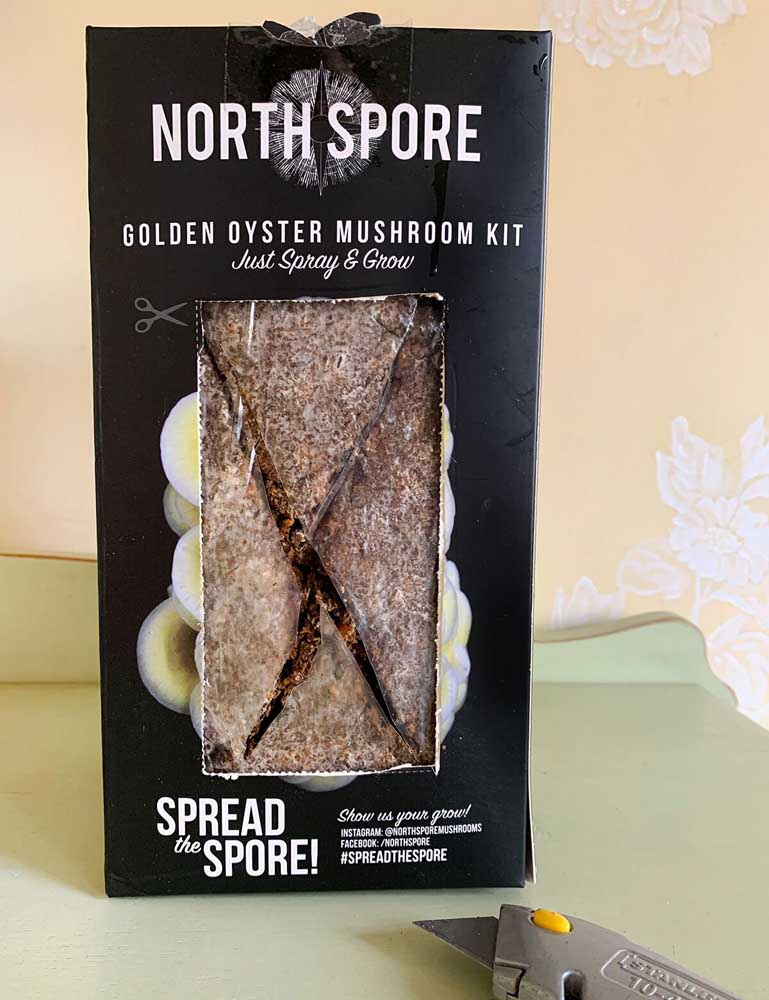Fungiculture: Everything you need to know about mushroom farming
Published 1:30 pm Tuesday, March 30, 2021

- North Spore's mushroom kit, split to start the fruiting process. Photo by Rosanne Toroian.
Have you ever wondered how mushrooms grow? In the wild, mushrooms reproduce by releasing spores, the fungi equivalent of plant seeds. The mixing of spores leads to the growth of mycelium, a root-like network of thin, white fibers that are often found underground or within trees and decaying logs. Mycelium produces pinheads which eventually “fruit” into full-sized mushrooms, completing the life cycle.
Humans have foraged wild mushrooms for thousands of years, but the ones you find in the store today were most likely grown on a farm. Americans favor the ubiquitous white button variety. It remains the most widely produced and consumed mushroom in the U.S., though consumer tastes have started branching out to other culinary species, such as shiitake, lion’s mane and oyster mushrooms. Many of these edible varieties are actually cultivated indoors, year-round. Mushroom farms are increasingly popular in cities, where fresh harvests of specialty varieties can be easily delivered to restaurants, grocery stores and farmers’ markets.
Trending
R&R Cultivation’s sustainable approach to mushroom farming
Today, urban farms like R&R Cultivation in Roseville, Minnesota, strive to create the most ideal conditions for mushrooms to grow, using a tightly controlled process that can be broken down into the following five stages:
1. Spawning
Indoor mushroom cultivation starts with spawn, which is a blend of spores and nutrient sources like grain, straw or wood chips. Spawn acts, roughly, like the mushroom equivalent of sourdough starter in bread baking. The initial nourishment provided by spawn helps speed up the rest of the growing process. Farmers can produce their own or purchase spawn from other suppliers. R&R Cultivation originally sourced organic spawn from Maine Cap N’ Stem before moving to a local supplier near the Twin Cities, New Hope Farmacy. Eventually, R&R plans to produce its own spawn in-house, a process that involves placing pieces of freshly cut mushrooms onto agar, a high-nutrient growing surface, to kickstart the growth of spores into mycelium.
2. Inoculation
Trending
The spawn is then added to substrate, which is a bulky growing medium, often wood pellets, sawdust, straw or coffee grounds, that is mixed with water and sealed in a bag. Mycelium uses the substrate for energy and nutrients as it continues to grow. The inoculation process requires a sterile environment to reduce the possibility of mold, bacteria or other fungi from competing with mushrooms for the substrate’s nutrients.
3. Incubation
The inoculated mix is placed in a warm, dark location to allow mycelium to completely colonize the substrate. Incubation can take anywhere from a few weeks to a few months, depending on the mushroom variety and growing conditions. Blue oysters are the most aggressive variety and will colonize within nine to 14 days, while shiitakes can take between 8 and 14 weeks.
4. Fruiting
After incubation, the bag is cut open in a temperature-controlled fruiting room to expose the colonized substrate to fresh air, humid conditions and a bit of light. Pinheads will start to form, eventually growing into mature mushrooms. The fruiting process varies by species; oyster mushrooms can be harvested in as little as a week, while pioppino and lion’s mane varieties take up to three or four weeks.
5. Harvesting
Harvest times vary depending on the species of mushroom, and each has its own indicator of maturity, but size is not one of them. For example, for a shiitake mushroom, the farmer looks at the mushroom’s veil, or the thin layer on top of the cap that’s attached to the stem covering the gills. When a mushroom reaches maturity, the veil will snap. Most farmers will harvest their mushrooms before the veil breaks. Oyster mushroom clusters should be picked before the caps start to flatten. Some mushroom varieties can be regrown in successive harvests, known as flushes.
According to Nick Robinson from R&R Cultivation, each flush will yield diminishing returns, and shiitakes won’t yield a fruitful second flush for their uses. Eventually, mycelium will deteriorate and stop producing new mushrooms. At R&R, the spent blocks of substrate are recycled into an official organics dumpster, which Robinson says will likely be used as beautiful compost for home gardens.
How to grow mushrooms at home
Want to try cultivating your own culinary mushrooms? Pre-colonized grow kits are an easy and inexpensive way to start. Available from online retailers and gardening stores, these kits come in the form of logs, bags or blocks. Simply provide the right fruiting conditions for the variety you wish to grow, and you’ll soon be harvesting tasty fungi in your own home. Oyster mushrooms are great for beginners as they’re one of the fastest-growing varieties and may deliver future yields through multiple harvests.
According to Robinson, the most important variables for growing oyster mushrooms at home are light, temperature and humidity. “Keep them cool, keep them moist,” he says. “You don’t want them in direct sunlight. Put your grow kit inside a plastic tub and spray it with a very fine mist to create a lot of humidity inside there.”
But, be careful.
While foraging for mushrooms in the wild can be a fun and rewarding activity, many common species are inedible, and some are even lethal if eaten. The best way to learn about safe and responsible mushroom hunting is from an expert. Seek out a local mushroom club or chapter of the North American Mycological Association for more information on guided foraging walks, newsletters and other educational programs.



